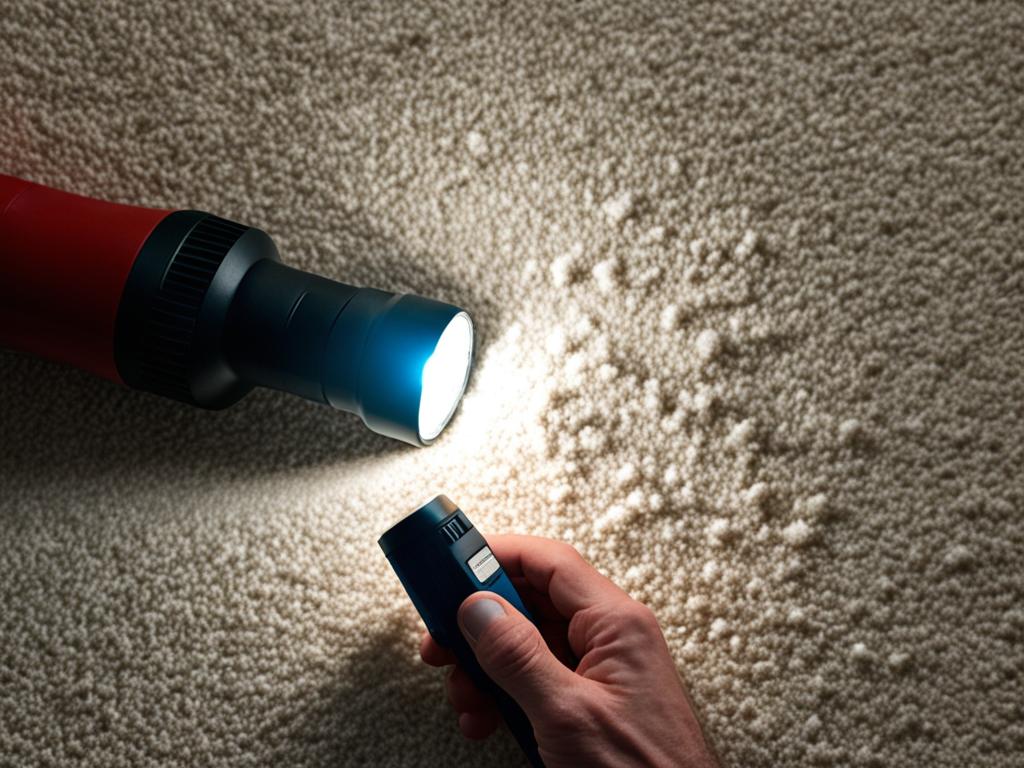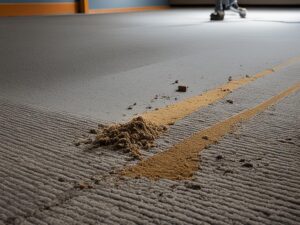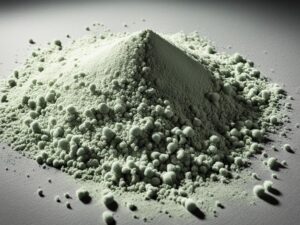Mold in carpets can be a common problem that not only affects the appearance of your home but also poses health risks. It’s essential to know how to check for and detect mold in your carpet to address the issue promptly. By following these simple steps, you can effectively identify mold in your carpet and take appropriate action to mitigate the problem and protect your home and loved ones.
Key Takeaways:
- Regularly inspect your carpet for signs of mold, such as a musty odor or color changes.
- Take note of any tiny mold spots or discolorations on the carpet’s surface.
- Consider professional mold testing or indoor air quality checks to ensure a thorough examination.
- Prevent carpet mold by ensuring proper installation and using high-quality padding.
- Regularly clean your carpets to reduce the chances of mold growth.
Signs of Mold in Carpet
When it comes to keeping your home clean and healthy, mold in your carpet is a problem that should not be ignored. Knowing the signs of mold in carpet is crucial for early identification and remediation. Here are some key indicators to watch out for:
- Moldy or musty smell: One of the most common signs of mold in carpet is a distinct odor. If you notice a persistent musty smell coming from your carpet, it may be an indication of mold growth.
- Color changes: Keep an eye out for any color changes in your carpet. Discoloration, stains, or a hazy look could be a result of mold infestation.
- Tiny mold spots: Look closely at your carpet for any small spots or specks that resemble minor discolorations. These could be tiny mold growths.
It’s important to note that mold can sometimes be hidden beneath the surface of the carpet, especially if there has been previous water damage. If you suspect mold but can’t see any visible signs, it’s recommended to seek professional assistance for a thorough inspection.
By identifying the signs of mold in your carpet early on, you can take prompt action to prevent further spread and minimize potential health risks. Regular maintenance and proper cleaning practices are essential in maintaining a clean and mold-free carpet environment.

Detecting Mold in Carpet
To detect mold in your carpet, there are several methods you can use. Some options include carpet mold testing, which involves taking samples from the carpet and sending them to a lab for analysis. Another method is to check the indoor air quality in your home, as mold can impact respiratory health. Additionally, signs of water damage, such as wet or sagging carpets, can indicate the presence of mold. Other indicators include burnt edges on the carpet, carpets that fold under when pressed, damage to the carpet, or parts of the carpet curling under. Any of these signs may suggest mold growth and should be investigated further.
| Methods for Detecting Mold in Carpet | Pros | Cons |
|---|---|---|
| Carpet Mold Testing | Provides accurate and scientific evidence of mold presence in the carpet. | Requires additional time and cost for sending samples to a lab for analysis. |
| Checking Indoor Air Quality | Allows for a broader assessment of mold contamination in the home. | May not specifically pinpoint mold in the carpet. |
| Identifying Signs of Water Damage | Can be a clear indication of mold growth, especially in damp areas. | Not exclusive to mold and may require further investigation. |
| Observing Other Indicators | Provides visual cues of possible mold growth in the carpet. | Some indicators may have other causes unrelated to mold. |
Carpet Mold Testing
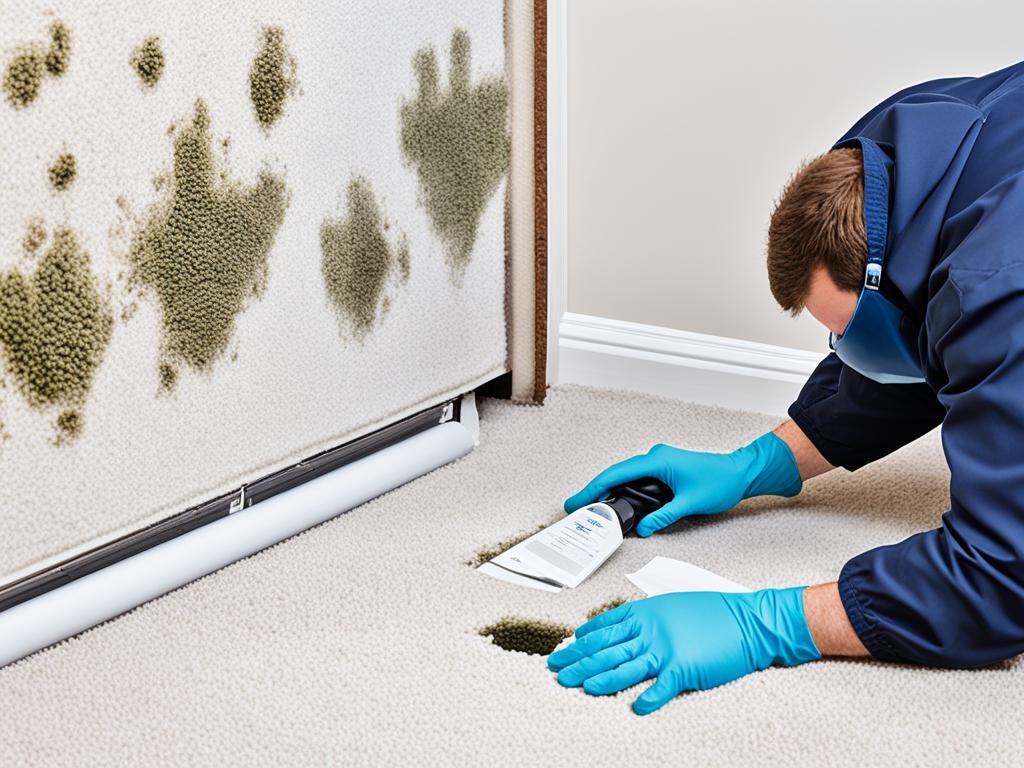
One reliable method for detecting mold in your carpet is through carpet mold testing. This involves collecting samples from various areas of the carpet and sending them to a professional laboratory for analysis. The lab will conduct tests to determine whether mold is present, identify the type of mold, and provide a comprehensive report of the findings. This testing method provides accurate and scientific evidence of mold presence in the carpet, allowing for targeted remediation efforts.
Preventing Carpet Mold
To prevent mold growth in your carpet, there are several preventive measures you can take. By implementing these precautions, you can ensure a clean and healthy environment in your home for you and your family.
1. Sensible Installation
During carpet installation, it is crucial to exercise caution and ensure sensible installation techniques. Avoid installing carpets in areas prone to moisture such as bathrooms, laundry rooms, or basements. Moisture can seep into the carpet, creating a breeding ground for mold. Proper installation techniques can significantly reduce the risk of mold growth.
2. High-Quality Padding
Using high-quality padding between the carpet and the floor is an effective way to prevent mold growth. Quality padding creates a barrier, reducing the absorption of moisture into the carpet fibers. Additionally, it enhances air circulation, preventing the accumulation of dust and moisture that can contribute to mold growth. Invest in high-quality padding to protect your carpet and prolong its lifespan.
3. Clean Carpets Regularly
Regular cleaning is essential to prevent mold growth in carpets. Vacuuming your carpets at least once a week helps remove dust, dirt, and other debris that can trap moisture or provide a food source for mold. Additionally, professional deep cleaning should be performed every 12 to 18 months to thoroughly remove any embedded dirt or allergens that may promote mold growth.
4. Professional Testing
Professional mold testing can play a vital role in preventing carpet mold. A certified mold inspector can conduct thorough testing to identify any potential mold issues early on. Their expertise and specialized equipment can detect even hidden mold growth. By identifying and addressing mold problems promptly, you can mitigate the risk of extensive damage to your carpets and ensure a healthy indoor environment.
By following these preventive measures, you can minimize the risk of mold growth in your carpets and maintain a clean, mold-free home.
| Preventive Measures | Benefits |
|---|---|
| Sensible Installation | Reduces moisture exposure |
| High-Quality Padding | Creates a moisture barrier |
| Clean Carpets Regularly | Removes potential food sources for mold |
| Professional Testing | Identifies and addresses mold issues promptly |
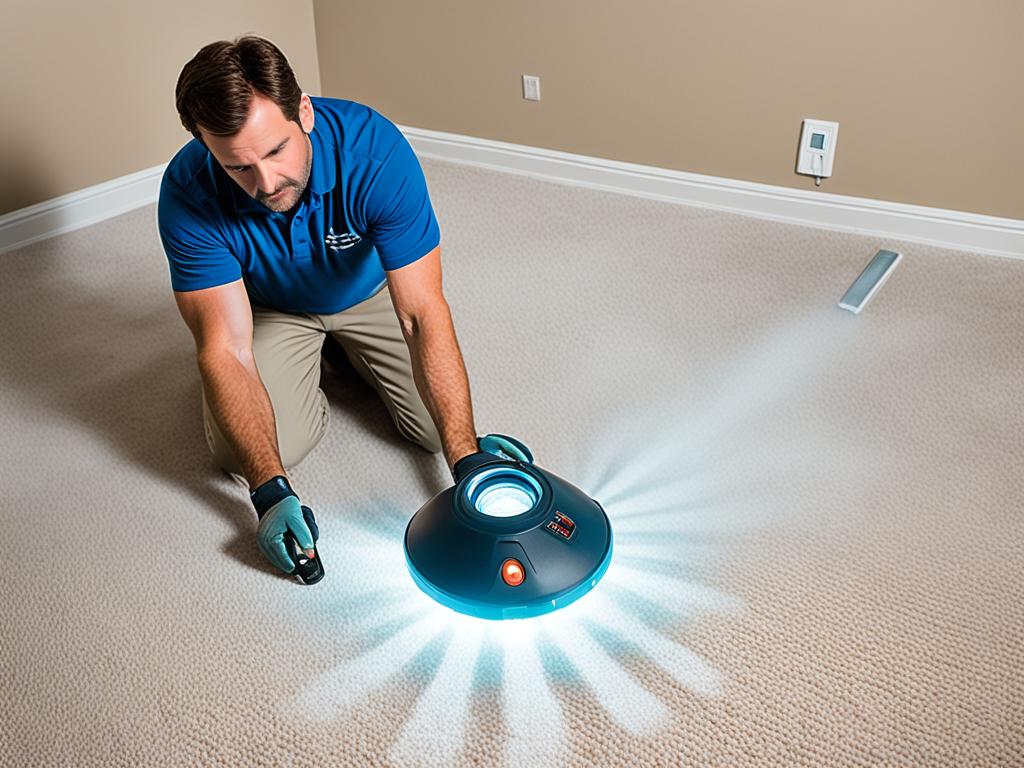
Conclusion
Mold in carpets is a serious concern that should not be underestimated. Identifying the signs of mold growth in your carpet and taking immediate action is crucial to maintain a healthy and safe living environment in your home. By being aware of the telltale signs of mold in your carpet, such as a musty odor, color changes, or visible spots, you can address the issue promptly.
When detecting mold in your carpet, it is important to take decisive measures to prevent any further damage. Conducting proper mold remediation for carpets is essential to mitigate potential health risks. Seeking professional assistance and guidance in this process is highly recommended to ensure effective mold removal and remediation. This will not only protect your home but also safeguard the health of you and your family.
Prevention is always better than cure when it comes to carpet mold. Taking proactive steps such as sensible carpet installation, using high-quality padding, and regular cleaning can help minimize the chances of mold growth. Additionally, professional testing can provide valuable insights into any potential mold issues, allowing for early intervention and mitigation.
Remember, your home deserves a clean and mold-free environment. By staying vigilant, taking necessary precautions, and addressing any signs of mold in your carpet promptly, you can create a healthy living space for you and your loved ones. Stay proactive and maintain the wellbeing of your home with efficient mold remediation for carpets.
